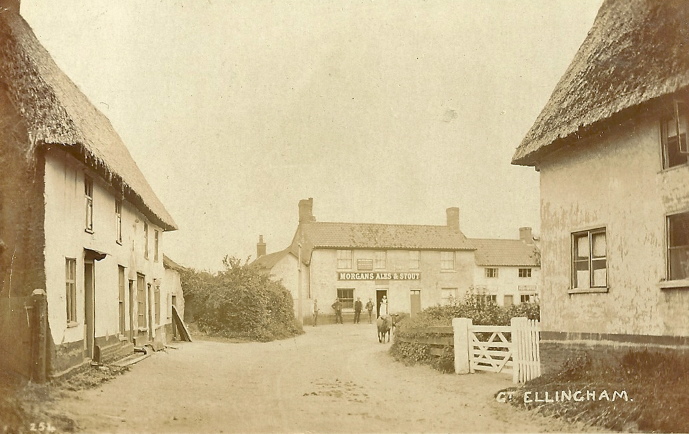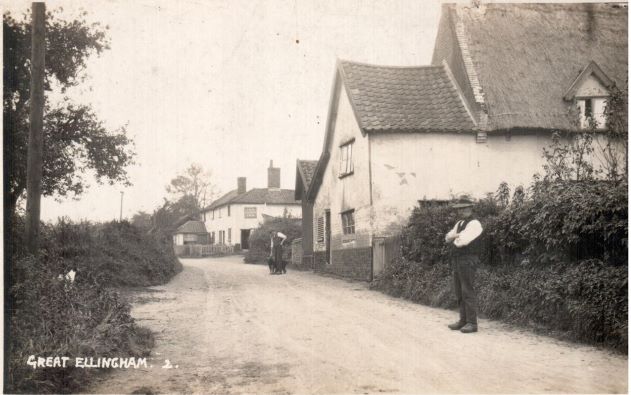


Increase
At the beginning of the 19th century, and over a period of 30 years, the population of Great Ellingham gradually increased from 655 in 1801 to 882 in 1831.
Decrease
However, save for a small increase in the populace in 1871, there began a steady decline in the population over the next 70 years. In 1901, there were just 583 inhabitants in Great Ellingham.
Nevertheless, the 20th century saw a significant rise in the population. The head-count for 2001 put the population of the village at 1,108 – nearly double that of 1901.
Dwellings
Similarly, during the 19th century, the number of inhabited houses in the village rose and then declined. In 1801, there were around 97 inhabited houses. The number increased to around 213 in 1851, but thereafter declined over the next 50 years to 146 in 1901.
Significant Decline
Although the village ‘lost’ some 80 or so inhabitants in 1836 due to emigration, the period which saw the largest decline in the population was between 1871 and 1881.
The census of 1881 records 94 less people in Great Ellingham than in 1871. I believe the movement of people out of the village was mainly due to the move from agriculture to industry. Entire families moved away from the village to find alternative work in the industrial north. One such family was Robert Lincoln who moved to Yorkshire with his wife and most of his children.
Snapshots of the Village in 1841 and 1851
The ten-yearly census provides us with a snapshot of the inhabitants of the village at that particular time.
In this blog, I particularly look at what the census returns of 1841 and 1851 tell us about the village.
I have mentioned the gradual decline in the population. Indeed, between 1841 and 1851 the populace of Great Ellingham decreased by 7.2%. However, in the same period the number of houses increased from 198 in 1841 (of which 187 were actually occupied) to 213 houses in 1851 (of which 201 were occupied).
In 1841, the total population of the village was 834 with a fairly equal number of male and females recorded on the census – 412 males and 422 females.
Ten years later, the population in 1851 stood at 774 with slightly more males than females – 398 males and 376 females.
In 1841, just 0.84% of the population in Great Ellingham were born outside the county of Norfolk. Whereas in 1851, this figure is 2.84%.
Unfortunately, the 1841 census does not specifically state the place of birth for the inhabitants, but it does tell us whether or not the person was born in or outside Norfolk.
However, the 1851 census does give the person’s place of birth. This is useful as we can tell how many people living in the village at that time were actually born in Great Ellingham. We should however bear in mind that there can be inaccuracies on the census returns for various reasons. For example, some people did not know exactly where they were born, and others may not want to reveal their actual place of birth.
Therefore we know that in 1851, 326 of the population of 774 (i.e. 42%) were not born in the village. However, of the 326, 304 were born in Norfolk (some in the adjoining towns or villages) leaving just 22 (2.84%) born out of the county.
Oldest and Youngest Inhabitants
1841
At the time of the 1841 census (undertaken on the night of the 6th June), the oldest persons living in the village were Mary Tooke and Susanna Fox who were both reported to be aged 85. However, either (or both) women may well have been older than 85. The census enumerators were told to round down to the nearest multiple of 5 the ages of those individuals aged 15 and over . Accordingly, the actual age of Mary Tooke and Susanna Fox was somewhere between 85 and 89.
The youngest inhabitants listed on the census were three infants all aged three months: Lydia Yeomans, Elizabeth Bartram and Samuel Reeder.
1851
In 1851, 94 year old Henry Rix was the oldest resident in Great Ellingham. The youngest was Alfred Le Grice, who was just 4 days old when the census was taken on the night of Sunday 30th March.
Life Expectancy
The average life expectancy at this time was low. In 1850 it was 40 years of age for men and 42 for women. However, the average figures include the many children who died in infancy and childhood. Having said that, those Victorians who reached adulthood could generally expect to live into old age. Of course, there are always exceptions.
Scholars
The census of 1841 does not tell us whether any children were receiving any form of education. However, the census does tell us that there were two School Mistresses and one School Master living in the village at that time. Accordingly, it is likely that some children were receiving at least basic education.
The 1851 census tells us that 60 children were ‘scholars’. One School Master and a School Governess lived in the village. Given that I have yet to find any evidence of a purpose built school prior to the erection of the British School in 1855, some of the children of the working class of Great Ellingham may have attended a small privately run school providing elementary education for a small fee, or a Sunday school. Of course, the very poor of the village would not be able to afford any fee.
Occupations
1841
The village seems to have been fairly self sufficient in both 1841 and 1851.
In 1841, the inhabitants could buy their groceries from the two grocers. One of the grocers also traded as a draper. There were also two butchers, two bakers, two dealers and two innkeepers.
Unsurprisingly, the village had four thatchers and three daubers. No doubt they were kept busy with the repair of the many thatched roofed clay lump dwellings in the village, alongside the 13 carpenters also in the village.
Great Ellingham also boasted five wheelwrights, four blacksmiths and three farriers.
There were two millers, five tailors and four straw bonnet makers. The villagers could have their boots mended by one of the nine shoemakers. Five women (or girls) were dressmakers.
Three women gave their occupation as ‘nurse’. These women were likely the ‘monthly nurses’ who attended a woman for the month following the birth of her child.
Of course it is no surprise to find that the majority of the inhabitants of Great Ellingham were employed on the land. Two men were gardeners. At least 91 men and boys were employed in agriculture, the majority of whom were agricultural labourers employed by some of the 33 farmers.
26 females were employed as servants with four females giving their occupation as housekeeper. 20 men were employed as servants, and there were five apprentices to tradesmen.
There were 15 inhabitants who classed themselves as ‘independent’ i.e. they financially supported themselves by an annuitant or other independent means. The census also mentions one Baptist minister and an army pensioner.
There may well have been more of the inhabitants in work but, for some reason, these have not been recorded on the census.
1851
Although the population of the village decreased by 7.2% from 1841, in 1851 the village continued to have a good selection of tradesmen living and working in the village.
Those who could afford to, could buy their cloth from one of three linen drapers, one of whom was also a grocer. Five tailors and seven dressmakers served the community. One of the tailors was also a hawker.
There were 28 farmers who farmed over 20 acres of land and who were also employers. There were also 13 farmers (including smallholders) who held under 20 acres of land. However, it can be difficult to identify the more affluent farmers. Some villagers may have classed themselves as ‘farmers’ even though they only worked a small piece of land. In addition, they may well have held other jobs as well as working their land.
There were also two shopkeepers, two bakers, a fishmonger and 10 dealers, some of whom dealt in poultry.
Although the village still has three thatchers and one dauber, there is now a brickmaker and a tile maker. In 1846, the Executors of the late Robert Large offered a ‘newly built Brick and Tiled Farmhouse in Hingham Road’ for sale at auction with a brick kiln adjacent.
The village was served by six shoemakers and a shoe binder. There were two hat makers and one woman calling herself a milliner. One woman sold flowers.
We also know that at least 19 villagers were reliant upon parish relief. In addition, 10 souls (who were not counted in those villagers claiming parish relief) were referred to as ‘paupers’. Given that this information was not provided by the 1841 census, it is difficult to know whether that standard of living for the inhabitants was any different from ten years earlier.
The village still had four blacksmiths. However, there were now only two wheelwrights and one farrier. One man was specifically referred to as a harness maker and two men working as tanners.
32 women and girls were classed as general house servants, whereas only three boys or men were general servants. Some 155 men and boys were working in agriculture. This figures includes farm labourers, agricultural labourers and farm bailiffs.
The village had two innkeepers – one of whom (Robert Lebbell) was also a blacksmith. However, there were also at least two beer-houses which are not specifically mentioned on the census. The selling of beer was sometimes ancillary to another occupation, but, more often than not, a man’s wife would carry out the brewing and selling of the beer from their home.
Five people classed themselves as ‘landed proprietors’ (i.e. that they lived off the income from the letting of dwellings or establishments) and six villagers were living on income from annuities. This number is four less than 10 years previously. In addition, Chelsea Pensioner, Jacob Carter, was still receiving his army pension. The village still had a Baptist Minister.
Although by 1851, the village had two working windmills (i.e. the tower brick windmill in the centre of the village and the post mill in Mill Lane), there was only one miller and an apprentice miller mentioned on the 1851 census.
The Next Ten Years
Between 1851 and 1861, the village saw its population decrease again by around 7.2% – a similar decline in the population as between 1841 and 1851.
Sources:
1841 census HO107/781/8 Enumeration Districts 8 & 9
1851 census HO107/1823 Enumeration Districts 4a & 4b
Postcards: Left – Church Street. Courtesy of Attleborough Heritage Group. Middle – Chequers Lane. Courtesy of Carol Ewin. Right – Long Street. Author’s own collection.